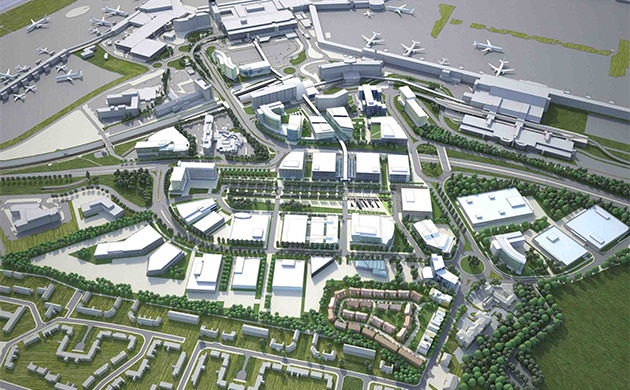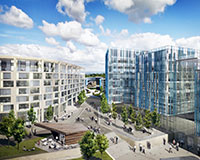Airport City Manchester has gone straight to the top to appeal to Chinese investors by hosting president Xi Jinping and offering a personalised welcome for newcomers to the northern powerhouse – from a concierge service to a plethora of noodle bars. Louisa Clarence-Smith meets the team behind the scheme to find out more
 How do UK property companies attract Chinese investors? Getting president Xi Jinping’s seal of approval is a good start. Combine that with a direct flightpath to Beijing and a personal concierge service offering advice on everything from getting a UK driving licence to where to source the nearest noodles, and you might be getting somewhere.
How do UK property companies attract Chinese investors? Getting president Xi Jinping’s seal of approval is a good start. Combine that with a direct flightpath to Beijing and a personal concierge service offering advice on everything from getting a UK driving licence to where to source the nearest noodles, and you might be getting somewhere.
Or at least, that is the hope of Argent’s senior project director Ruairidh Jackson, the man in charge of delivering the £130m-£160m China Cluster at Airport City Manchester – a joint venture between Manchester Airport Group, Carillion, Beijing Construction Engineering Group and the Greater Manchester Pension Fund.
Shenzhen Gardens and Wuhan Square, which make up the 484,000 sq ft cluster unveiled by the Chinese president in October 2015 on his first trip to Manchester, would be a jewel in the northern powerhouse crown if the joint venture successfully lures Asian investors and occupiers.
Now it is Jackson’s job to turn the initial frenzy into concrete investment. He has spent the past year flying back and forth to China carrying a photo of the president standing next to a model of the scheme in a bid to secure some deals.
“Already the feedback we are getting is that the northern powerhouse has created the window,” he says. “People are interested. And we have products that are really exciting.
“What we are now doing is following that up, going back to China, saying, ‘Here is a photograph of the president next to the model. He thought it was great and you will too.’”
Wuhan Square will become a new hub for more traditional HQ-style offices with a hotel and serviced apartments, connected at ground level by a covered walkway to protect workers from rain.
Shenzhen Gardens, meanwhile, will target tech companies and SMEs with a modular design of offices made up of components prefabricated or partially prefabricated in the UK or China. It will be flexible and quick to build.
Among those rumoured to be already in talks to take space at the cluster is HNA Group, the parent company of Hainan Airlines, which will begin operating a new route between Manchester and Beijing Capital International Airport from June 2016.
The deal would be a coup for Argent and the joint venture, as it would represent HNA’s first office letting in the UK since its purchase of the Reuters HQ at 30 South Colonnade, E14, in September 2015.
“The types of business that we are looking to engage with in China are usually already very strong in their own domestic market. They will have internationalised to a degree, possibly into Africa or North America, and will be looking to establish a presence in Europe,” Jackson says.
“What is slightly different, I suppose, is that a lot of the international focus and direction of businesses will be influenced by the state’s rolling five-year plan.”
At the moment, the state’s emphasis is on advanced manufacturing and high-end logistics, he says, which are exactly the kinds of businesses it hopes to attract to Shenzhen Gardens.
Designed by Ben Adams Architects, the scheme is inspired by both the large warehouses of central Manchester and the hutong, a traditional Chinese architectural form now most associated with shopping centres. Both structures tend to consist of large building blocks surrounding a central space or courtyard.
“The focus is perhaps on businesses with smaller needs and flexible needs for space,” says Ben Adams, founder of the architectural practice.
“So they might want a few thousand square feet in order to quickly open an office to deal with a particular contract. That might last for a period of time and then disappear again; or they might want a few thousand square feet which then suddenly becomes 50,000 square feet for a period of time and then shrinks again.”
Designs have yet to be finalised, but a possible option is to build an external frame, which would then be filled in with modules from the outside as occupiers sign up for space.
“We are hoping that you can configure this in a way that you might buy a car,” says Adams, “in that you say, ‘OK, I want that kind of model, but then I want leather seats and a bigger engine; or actually I don’t want any of that, I want it to be cheap and really simple.’
“We think we can offer that kind of flexibility just by designing it from the start and then letting people choose, as long as the parameters of what it is are locked down, so you can’t choose to build a tower. It is not that level of choice.”
Jackson is also keen to highlight the architectural design as a key selling point of the scheme for Chinese occupiers.
“It speaks to the type of advanced manufacturing businesses that would be wanting to come to Manchester because of the city’s established reputation in advanced materials and other sectors like that, which it has had from the industrial revolution to graphene, and which is part of the Manchester story,” he says.
“But also, and this is my personal romanticism I suppose, it ties to the airport as a place. The romance of travel went out of fashion a long time ago, but they are still highly engineered environments where very technically advanced pieces of machinery take off and land every couple of minutes. And the buildings in some way reference that.”
Another advantage of the cluster’s airport location is its position within an enterprise zone – which gives companies
a business-rates exemption of up to £275,000 for the first five years.

Jackson says the enterprise zone translates well internationally because it is seen as a government-approved location for business. “And particularly in countries where there is very centralised control, it is seen as implicit that it will be a lot easier – there will be a lot less red tape.”
But in case that is not enough to lure Chinese companies to Airport City, the joint venture has gone one step further by setting up two concierge schemes designed to assist with the culture shock.
Connect Business is a “one-stop-shop online portal” for incoming overseas businesses that holds information about floorspace and occupation, as well as independent advice from Deloitte, Addleshaw Goddard and Eversheds.
Connect Life is designed to assist occupiers when they arrive with information on how to use local transport, get a driving licence, find a school for their children and order food from Manchester’s Chinatown.
“You try to put yourself in the shoes of someone who is coming to a new country for the first time and there will be
a business decision made about moving there,” Jackson says. “The productivity and the happiness of the people when they come will, to a large extent, dictate whether they take more floor space at Airport City or move somewhere else, how their business grows and that kind of thing.”
Despite the Asian-focused marketing campaign, he is keen to emphasise that the scheme is not envisaged to be taken up by Chinese occupiers alone.
“Most office occupation at any scheme is driven by existing businesses in the local catchment looking to relocate or consolidate,” he says. “So a large proportion of Airport City overall will be businesses that are already in the UK but are looking to either northshore out of London into Manchester or consolidate from Warrington and places like that closer to the urban core.
“And then there are international businesses. China is a large growth market, but it is growing from a very small base. About 30% of all foreign direct investment into Greater Manchester in the past 10 years has been from the US and we are certainly not in the business of precluding any international business from coming here.
“It is not an exclusive domain for China or for anyone else.”
Indeed, Airport City as a whole, which spans 160 acres and has 93 different plots available, most recently secured Amazon to take a 130,000 sq ft shed in its logistics-focused Airport City South.
However, the clue is in the name for the China Cluster, which is pitched in Chinese in marketing materials as part of the “City of Wonder” and “gateway to Europe and beyond”.
Argent and Ben Adams Architects now have six months to prepare as much as they can for a delegation of potential Chinese investor-occupiers they hope to bring over for a visit after the Chinese new year. Will the visitors be convinced?
Jackson is confident they will be, but admits the CGIs portray a slightly brighter climate than the realities of the North of England.
“I did get a comment from one person working in China who said the thing he thought the biggest positive from the first brochure we published was that there was an absence of smog – a regular challenge at home [in China].
“He said, ‘Wow, you can see the blue sky.’ I didn’t have the heart to tell him that it might be raining.”











